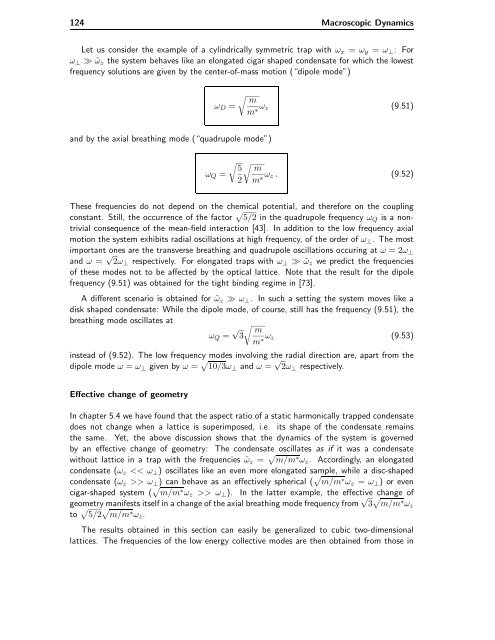Bose-Einstein Condensates in Rotating Traps and Optical ... - BEC
Bose-Einstein Condensates in Rotating Traps and Optical ... - BEC
Bose-Einstein Condensates in Rotating Traps and Optical ... - BEC
Create successful ePaper yourself
Turn your PDF publications into a flip-book with our unique Google optimized e-Paper software.
124 Macroscopic Dynamics<br />
Let us consider the example of a cyl<strong>in</strong>drically symmetric trap with ωx = ωy = ω⊥: For<br />
ω⊥ ≫ ˜ωz the system behaves like an elongated cigar shaped condensate for which the lowest<br />
frequency solutions are given by the center-of-mass motion (“dipole mode”)<br />
ωD =<br />
<br />
m<br />
ωz<br />
(9.51)<br />
m∗ <strong>and</strong> by the axial breath<strong>in</strong>g mode (“quadrupole mode”)<br />
ωQ =<br />
<br />
5 m<br />
2 m∗ ωz . (9.52)<br />
These frequencies do not depend on the chemical potential, <strong>and</strong> therefore on the coupl<strong>in</strong>g<br />
constant. Still, the occurrence of the factor 5/2 <strong>in</strong> the quadrupole frequency ωQ is a nontrivial<br />
consequence of the mean-field <strong>in</strong>teraction [43]. In addition to the low frequency axial<br />
motion the system exhibits radial oscillations at high frequency, of the order of ω⊥. Themost<br />
important ones are the transverse breath<strong>in</strong>g <strong>and</strong> quadrupole oscillations occur<strong>in</strong>g at ω =2ω⊥<br />
<strong>and</strong> ω = √ 2ω⊥ respectively. For elongated traps with ω⊥ ≫ ˜ωz we predict the frequencies<br />
of these modes not to be affected by the optical lattice. Note that the result for the dipole<br />
frequency (9.51) was obta<strong>in</strong>ed for the tight b<strong>in</strong>d<strong>in</strong>g regime <strong>in</strong> [73].<br />
A different scenario is obta<strong>in</strong>ed for ˜ωz ≫ ω⊥. In such a sett<strong>in</strong>g the system moves like a<br />
disk shaped condensate: While the dipole mode, of course, still has the frequency (9.51), the<br />
breath<strong>in</strong>g mode oscillates at<br />
ωQ = √ <br />
m<br />
3 ωz<br />
(9.53)<br />
m∗ <strong>in</strong>stead of (9.52). The low frequency modes <strong>in</strong>volv<strong>in</strong>g the radial direction are, apart from the<br />
dipole mode ω = ω⊥ given by ω = 10/3ω⊥ <strong>and</strong> ω = √ 2ω⊥ respectively.<br />
Effective change of geometry<br />
In chapter 5.4 we have found that the aspect ratio of a static harmonically trapped condensate<br />
does not change when a lattice is superimposed, i.e. its shape of the condensate rema<strong>in</strong>s<br />
the same. Yet, the above discussion shows that the dynamics of the system is governed<br />
by an effective change of geometry: The condensate oscillates as if it was a condensate<br />
without lattice <strong>in</strong> a trap with the frequencies ˜ωz = m/m ∗ ωz. Accord<strong>in</strong>gly, an elongated<br />
condensate (ωz > ω⊥) can behave as an effectively spherical ( m/m ∗ ωz = ω⊥) oreven<br />
cigar-shaped system ( m/m ∗ ωz >> ω⊥). In the latter example, the effective change of<br />
geometry manifests itself <strong>in</strong> a change of the axial breath<strong>in</strong>g mode frequency from √ 3 m/m ∗ ωz<br />
to 5/2 m/m ∗ ωz.<br />
The results obta<strong>in</strong>ed <strong>in</strong> this section can easily be generalized to cubic two-dimensional<br />
lattices. The frequencies of the low energy collective modes are then obta<strong>in</strong>ed from those <strong>in</strong>




